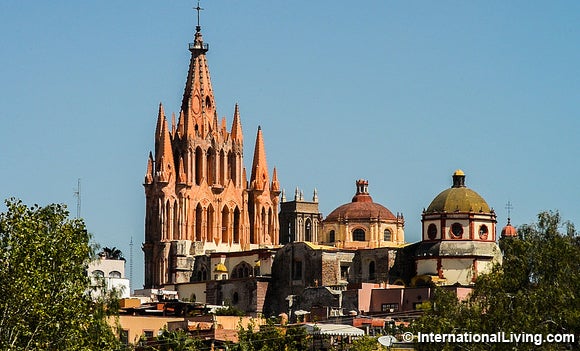By Dan Prescher, InternationalLiving.com
Over the past couple of years, something remarkable—and unsettling—has happened to the middle class in the U.S.

San Miguel de Allende, Mexico
A Pew Research Center analysis of government data shows that, after nearly 40 years as the majority economic class in the U.S., the middle class in 2015 became smaller than the economic classes above it and below it. The middle is shrinking.
If you’re moving up, good for you.
But most people I know are either scrambling harder than ever to hang onto their middle-class status or sliding slowly and painfully out of it.
The concept of a “middle class” is, of course, a relative and somewhat arbitrary one. In the study mentioned above, the middle class in the U.S. is defined as adults whose annual household income is two-thirds to double the national median: that is, about $42,000 to $126,000 annually in 2014 dollars for a household of three.
I don’t know about you, but $42,000 a year in most places I’ve lived in the U.S. doesn’t get the job done anymore…not after rent or mortgage payments, health insurance, home and vehicle insurance, local/state/federal taxes, utilities, transportation…
When looked at this way, the middle seems a lot closer to the bottom, and it’s getting closer all the time. But, as I said, the concept of a “middle class” is a relative and somewhat arbitrary one. For example, try this thought experiment.
Imagine trying to live in a place where $42,000 might just get you through an entire year…as long as the car or the furnace doesn’t break down, the roof doesn’t spring a leak, the price of gas or electricity doesn’t go up, your taxes don’t go up, your rent doesn’t go up, you or your spouse don’t get sick, or the government doesn’t decide to reduce or eliminate whatever programs you’re counting on to help with health insurance and pension income.
Doesn’t make a “middle-class” income seem very middle class, does it?
Now imagine living in a place where $42,000 can comfortably get a couple through an entire year—in style—and leave you $18,000 to put in the bank.
No need to worry about the furnace or the price of utilities, because the weather is so good year-round that you don’t need a furnace, and the rest of your monthly utilities amount to the price of a nice dinner.
No need to worry about car repairs…or insurance…or gas…or even buying a car in the first place…because public transportation is everywhere, all the time, and costs just a quarter to a few dollars a ride.
No need to worry about taxes, because property and municipal taxes rarely go over $100 a year.
No need to worry about getting sick, because you have two or even three healthcare systems to choose from…public, private, or hospital-based…and all are cheaper than comparable costs in the U.S.
In this thought experiment, you’re living in a warm, inviting place, with a cost of living so low that it’s actually a stretch to spend more than $2,000 to $3,000 a month on a high-quality lifestyle.
In this thought experiment, $42,000 a year puts you right back at the top of the middle class, and then some.
The only trick to turning this thought experiment into reality is picking the right place and moving there.
My wife and I did exactly that 15 years ago. We moved abroad, first to Ecuador, then to Mexico, then to five other communities in another couple of Latin American countries. In each one—on what we would have spent back in the States just to pay the mortgage, keep the furnace running, and insure the car—we had no trouble affording the best of everything those countries had to offer.
We’ve had the same experience many North American expats have when they move to more affordable countries: We are often automatically assumed to be rich by the locals. And compared to the locals, the income that is barely letting us scrape by back home actually does make us comparatively rich.
If the cost of living where you are now is pushing you out of the middle class, the right place with a lower cost of living can put you right back in it.
At this very moment you’re reading a magazine that has been around for 36 years for that single purpose: to show you the very best of those places and how to live in them.
These places are so affordable that they can turn an income that barely qualifies as a subsistence income in the U.S. into one that puts you very near the top of the heap.
The idea of moving up in economic class simply by moving to a more affordable place isn’t new. But until a few decades ago, doing it with the right information and resources was a challenge. It was a hit-or-miss proposition. You bought your ticket, and you took your chances.
Today that has all changed. All the research you need to help make an informed choice is right at your fingertips. The research, the reports, the on-the-ground resources, and (most critically) the years of experience in assessing overseas destinations, can all be found at the turn of a page or tap of a button.
The thought experiment I mentioned above is one that millions of people have already done. And hundreds of thousands of them have turned it into a reality. In this sense, the middle class isn’t shrinking.
It’s just moving someplace simpler, warmer, and more affordable.
This article comes to us courtesy of InternationalLiving.com, the world’s leading authority on how to live, work, invest, travel, and retire better overseas.
Related Articles
